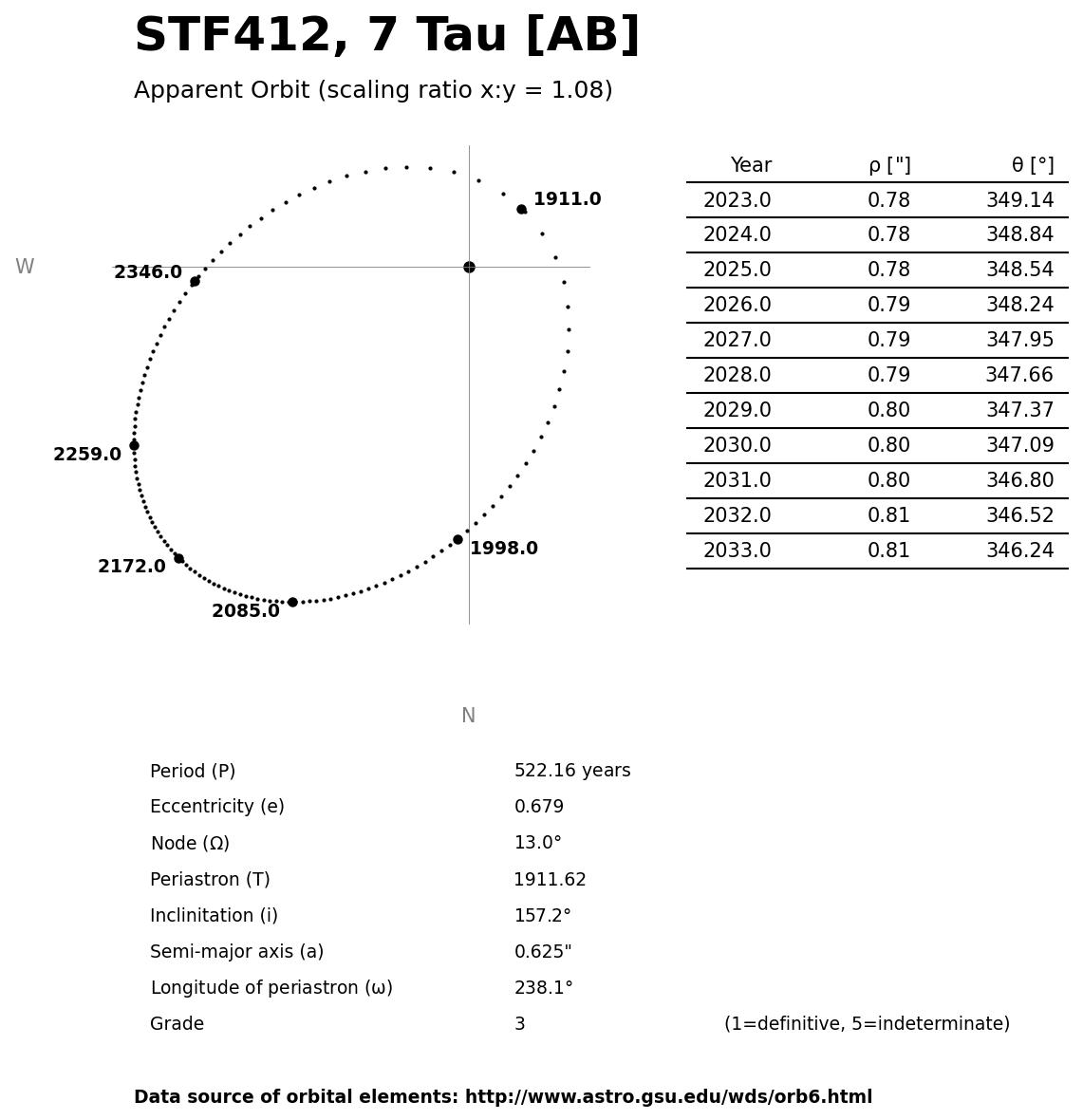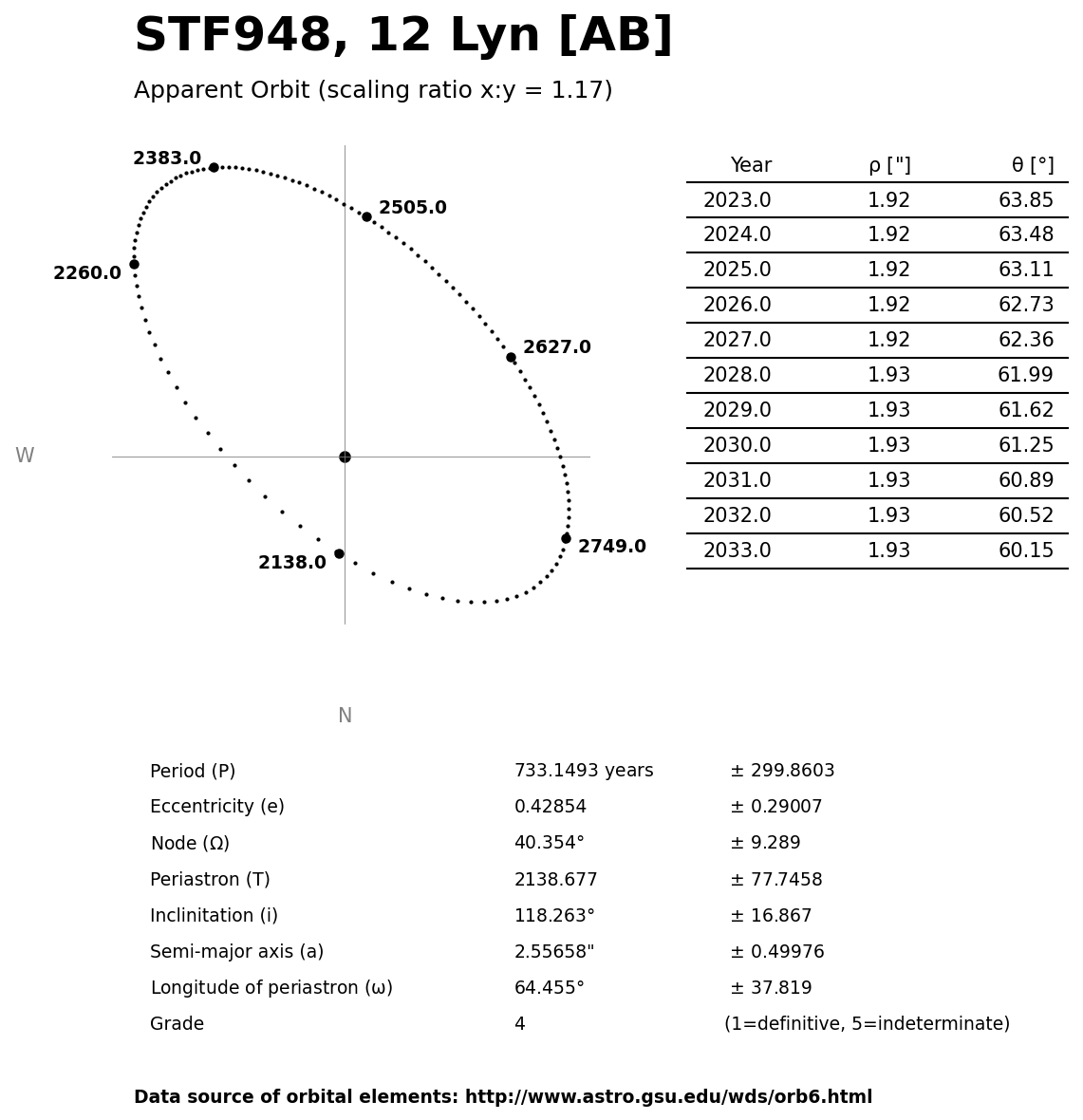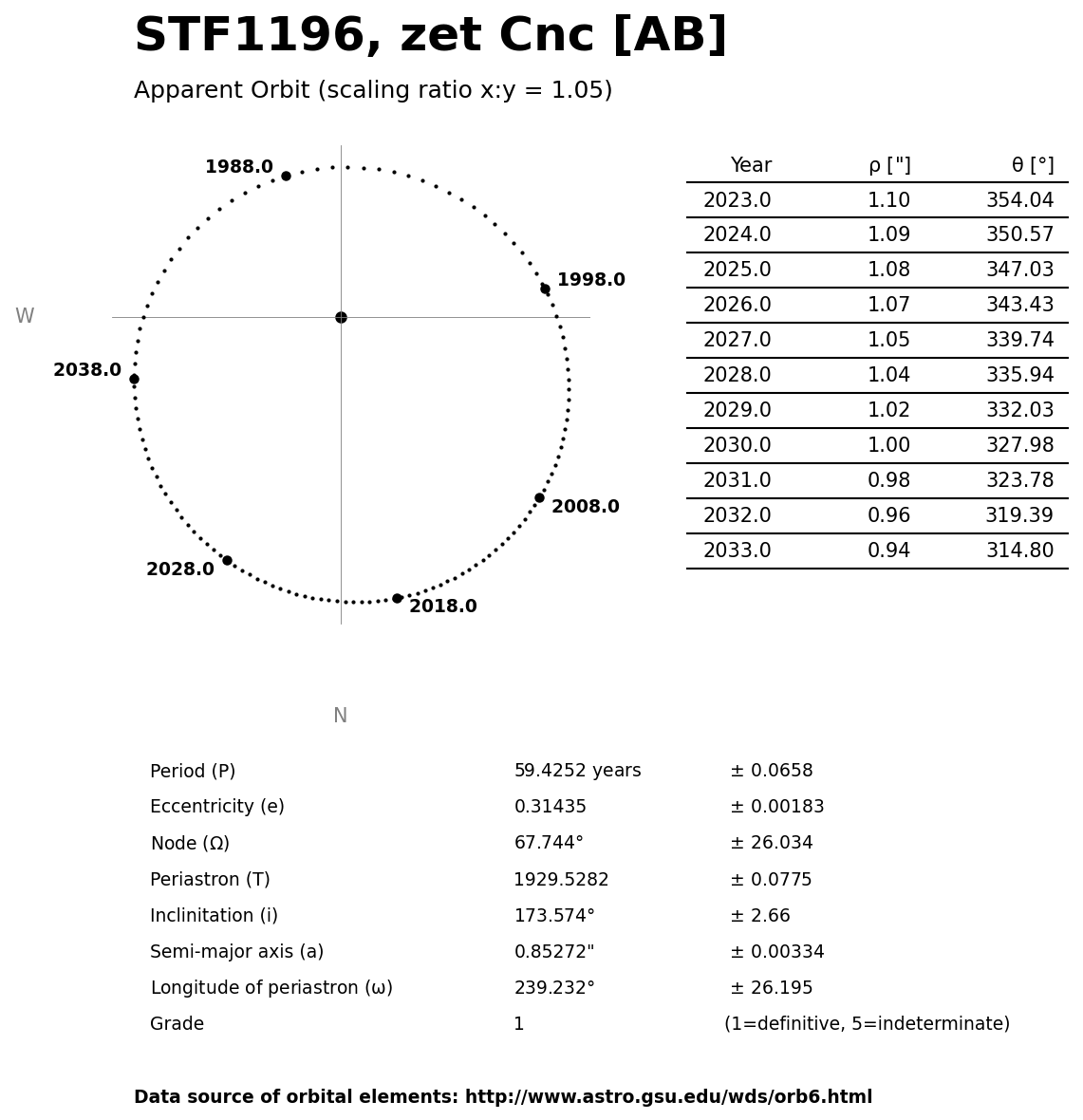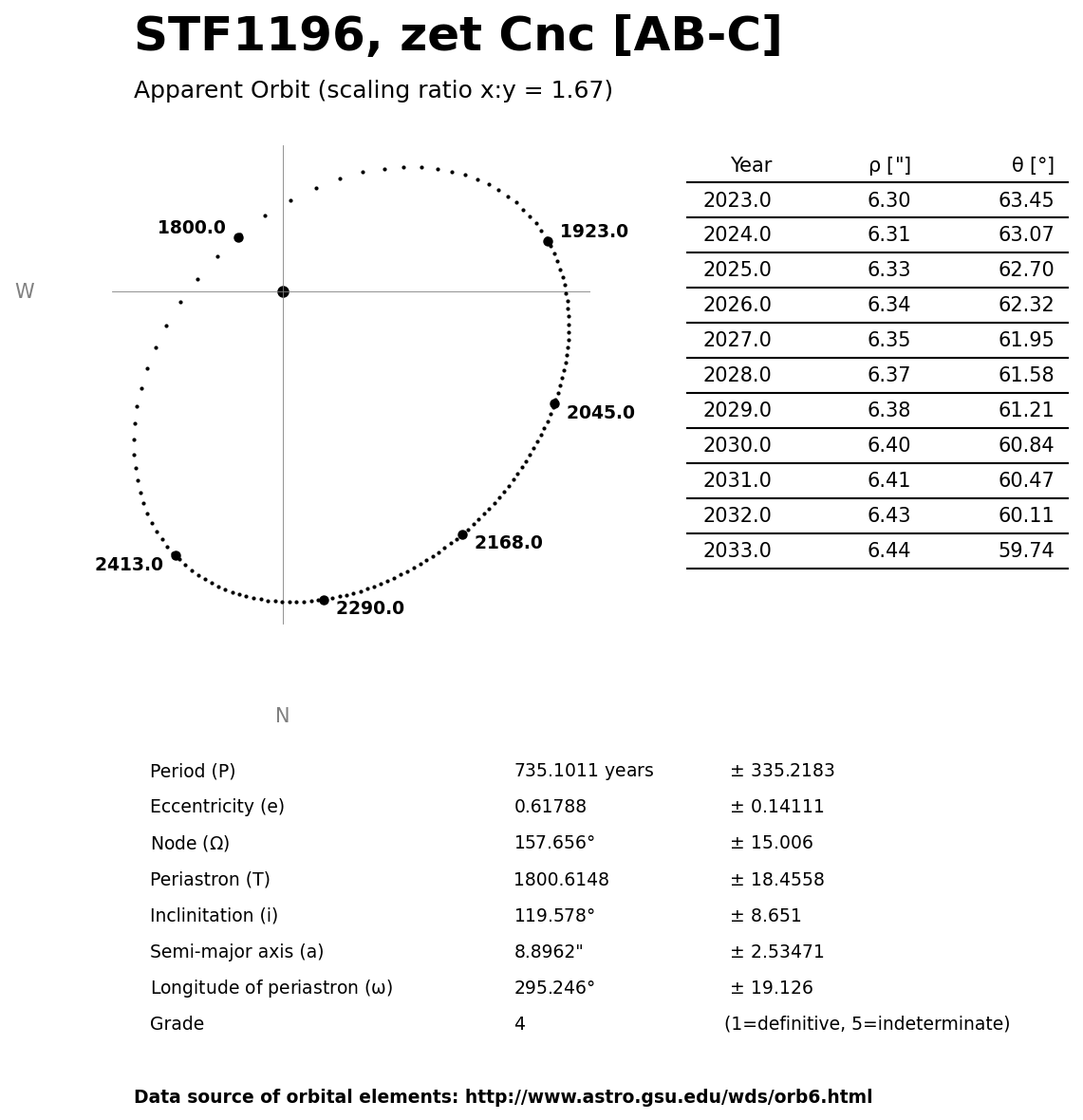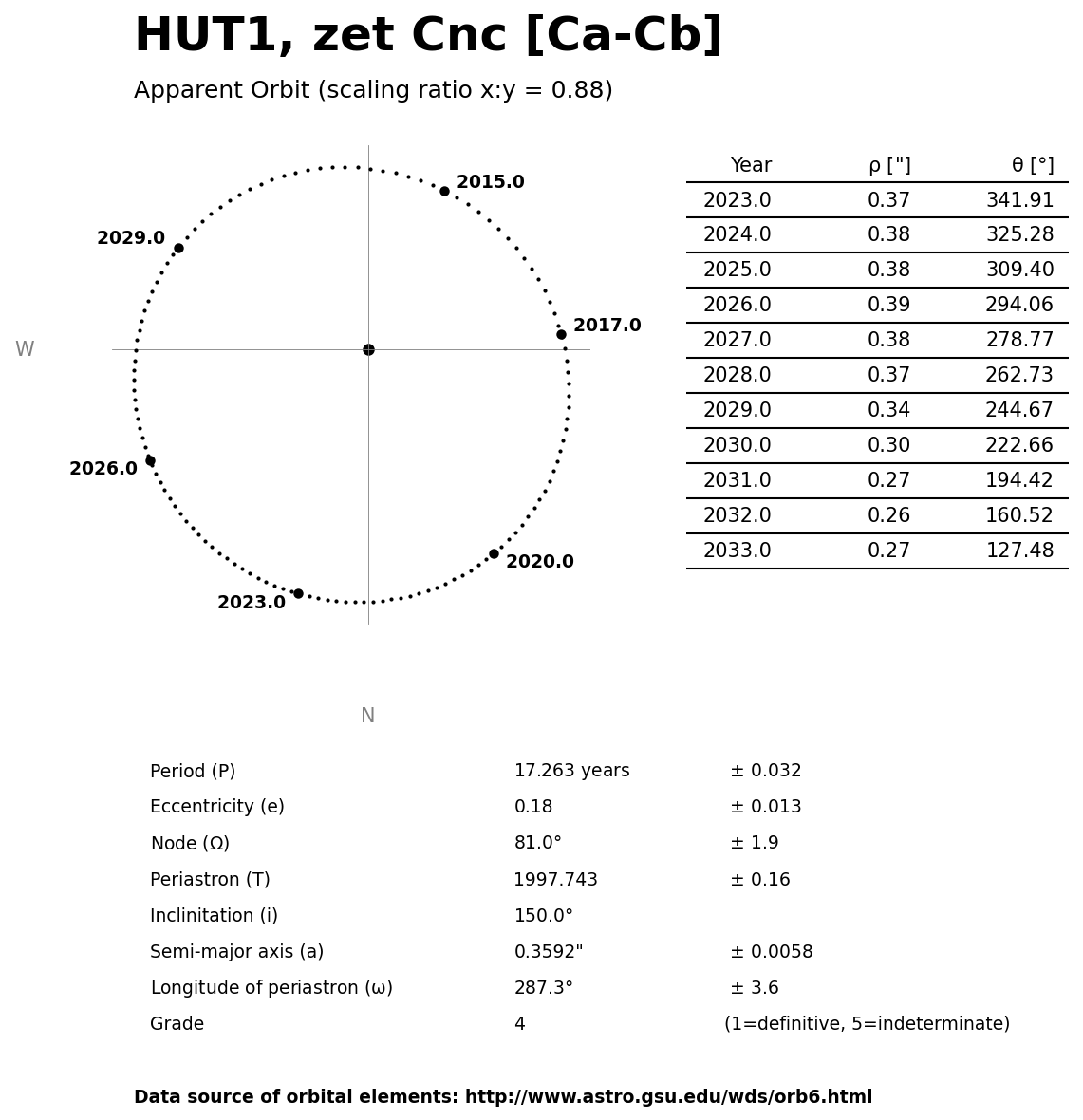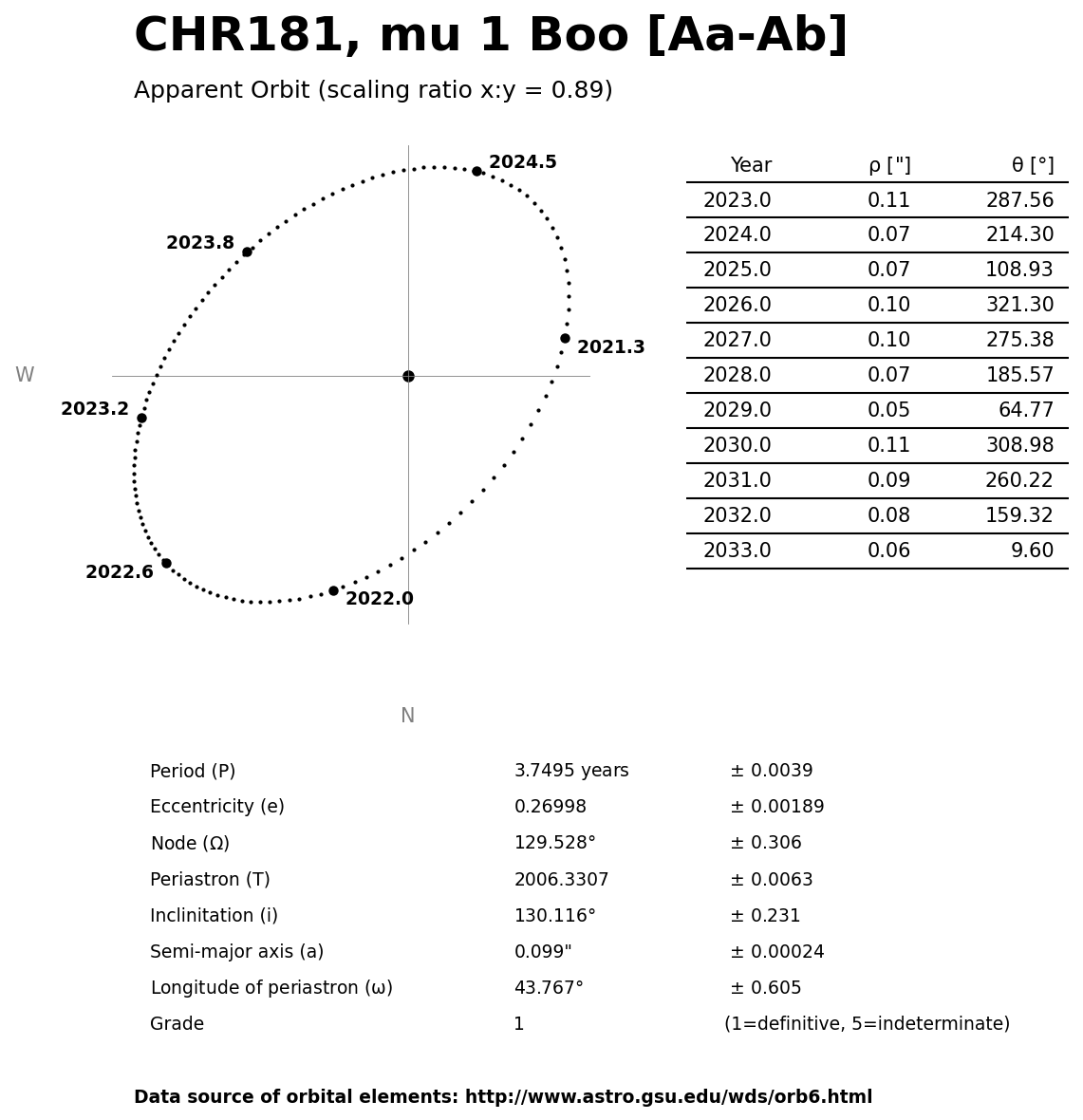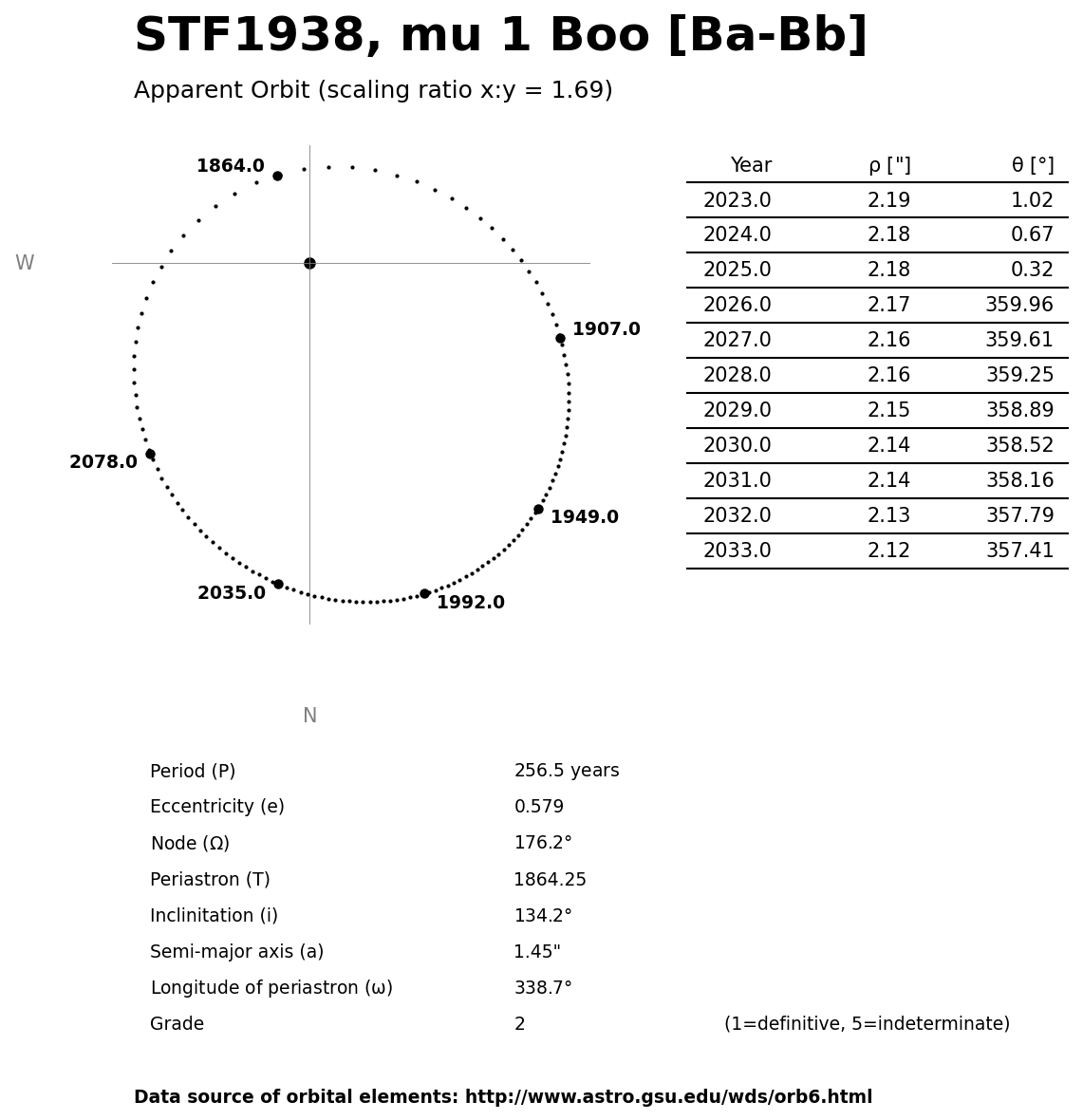|
m1 |
m2 |
ρ |
θ |
Year |
|
Coordinates (J2000.0) |
|
★★★
|
STF412, 7 Tau |
|
AB |
6m.6 |
6m.9 |
0.8" |
350° |
2019 |
Tau |
03h34m26.62s / +24°27'52.10" |
|
|
|
|
AB-C |
5m.9 |
9m.9 |
22.4" |
53° |
2014 |
|
|
|
|
Uwe Pilz
Leipzig (Germany) |
105mm (260x) |
AB: A-B länglich |
|
Christopher Hay
Seeheim (Germany) |
180mm (110x) |
No definite elongation of AB seen at 110x, seeing is poor. But nice pinprick of light wide off to NE, seems bluish, this is the C component.
AB-C is physical at 429 light years distance from us, and so is A-B, so this is a physical triple system. Very easy to find 3° due west of the Pleiades. |
|
Mark McCarthy
Fremont (California/USA) |
508mm (333x) |
AB: Exciting 2+1 set. AB is brilliant near equal white, nice close split <1". C is a much fainter wider star. I also cleanly split AB with the 8-inch mask, but the dark gap was narrower. Physical with a 522.16-year period |
|
|
|
★★★
|
sigma Ori, 48 Ori |
BU1032 |
AB |
4m.1 |
5m.3 |
0.3" |
70° |
2018 |
Ori |
05h38m44.77s / -02°36'00.20" |
|
|
|
STF762 |
AB-C |
3m.8 |
8m.8 |
11.4" |
239° |
2019 |
|
|
|
|
|
STF762 |
AB-D |
3m.8 |
6m.6 |
12.9" |
83° |
2019 |
|
|
|
|
|
STF762 |
AB-E |
3m.8 |
6m.3 |
41.4" |
62° |
2019 |
|
|
|
|
|
STF3135 |
AB-F |
3m.8 |
7m.9 |
208.0" |
324° |
2016 |
|
|
|
|
|
STF762 |
DC |
6m.6 |
8m.8 |
23.8" |
252° |
2019 |
|
|
|
|
|
STF762 |
EC |
6m.3 |
8m.8 |
52.9" |
241° |
2019 |
|
|
|
|
|
STF762 |
ED |
6m.3 |
6m.6 |
29.8" |
232° |
2019 |
|
|
Christopher Hay
Seeheim (Germany) |
10x42 |
Binoculars with internal stabilisation, handheld.
AB-D: No split, nor any elongation of AB towards D seen.
AB-E: E is set off well from AB but harder to split than the numbers would suggest. This is partly due to the major delta-mag, and partly to the circumstance that D effectively reduces the "free" stretch of sky to 29".
STF761 is a nice complement a few minutes of arc to the west and makes the visual impression of possibly belonging to the Sigma Ori complex, but Stelledoppie doesn't confirm this. |
|
René Merting
Drachhausen (Germany) |
12x42 |
AB-E: Komponente E ist nordöstlich abgesetzt von AB zu erkennen
AB-H: die relativ helle Komponente H steht in weitem Abstand im Südosten von AB |
|
Christopher Hay
Seeheim (Germany) |
15x45 |
Binoculars with internal stabilisation, handheld.
AB-D: No split acheived. However, focussing on AB feels uncertain, presumably due to disturbance by D. Also not split with 15x60 on tripod.
AB-E: E is set off well from AB. |
|
Christopher Hay
Seeheim (Germany) |
25x80 |
AB-D: D is set off nicely from AB and appears very slightly on the orange side, particularly in contrast to E. |
|
Christopher Hay
Seeheim (Germany) |
60mm (50x) |
AB-D: wide split, D is reddish. C not seen, perhaps seeing is too poor at time of observation. |
|
René Merting
Drachhausen (Germany) |
100mm (64x) |
AB-C: bei 64x zeigt sich Komponente C ganz schwach südwestlich von AB
AB-D: bei 32x schließt sich an die zartgelbe Komponente AB unmittelbar im Osten dicht stehend D weißorange an - ein schickes Trio zusammen mit E weiter östlich
AB-E: bei 32x zeigt sich in vierfacher Entfernung von AB-D die Komponente E weiter östlich in einer Linie - E ist ähnlich hell wie D |
|
Sarah Gebauer
Germany |
150mm (125x) |
ein sehr schönes Muster des Mehrfachsystems, auch wenn längst nicht alle Komponenten getrennt zu sehen waren, AB-C, AB-D und AB-E getrennt, A und B nicht |
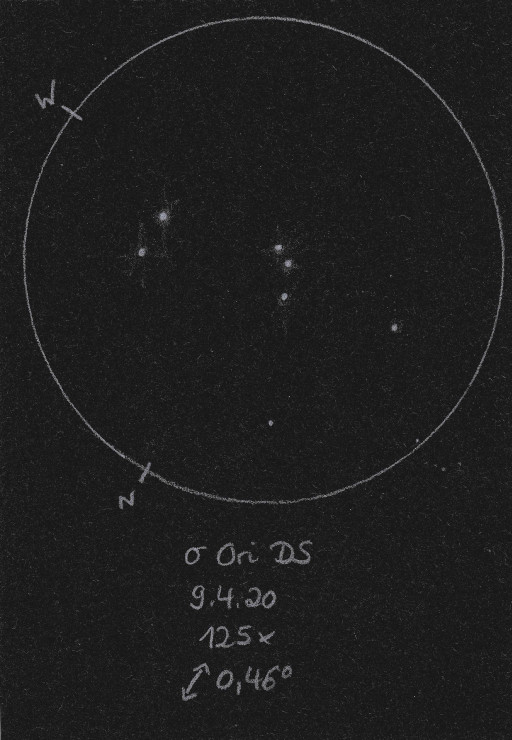
|
Uwe Pilz
Leipzig (Germany) |
320mm (80x) |
AB-C-D schon im Aufsuchokular sichtbar. Sehr lebhafte Farben, einer der schönsten Mehrfachsterne überhaupt. Im selben Feld mit STF761 |
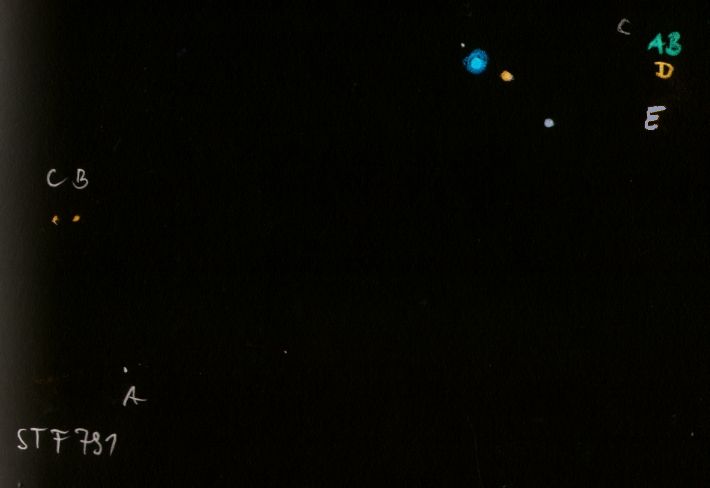
|
|
|
★★★
|
STF948, 12 Lyn |
|
AB |
5m.4 |
6m.0 |
1.9" |
65° |
2020 |
Lyn |
06h46m14.15s / +59°26'30.10" |
|
|
|
|
AC |
5m.4 |
7m.0 |
8.9" |
309° |
2019 |
|
|
|
|
Robert Zebahl
Leipzig (Germany) |
55mm (27x) |
AC: Components A/B and C well separated, but tight. Significant difference in brightness. The fainter C companion appeared slightly orange, the brighter one white-bluish. |
|
Robert Zebahl
Leipzig (Germany) |
55mm (167x) |
AB: Components A and B separated, whereby the Airy disks slightly overlap. The difference in brightness was well visible. |
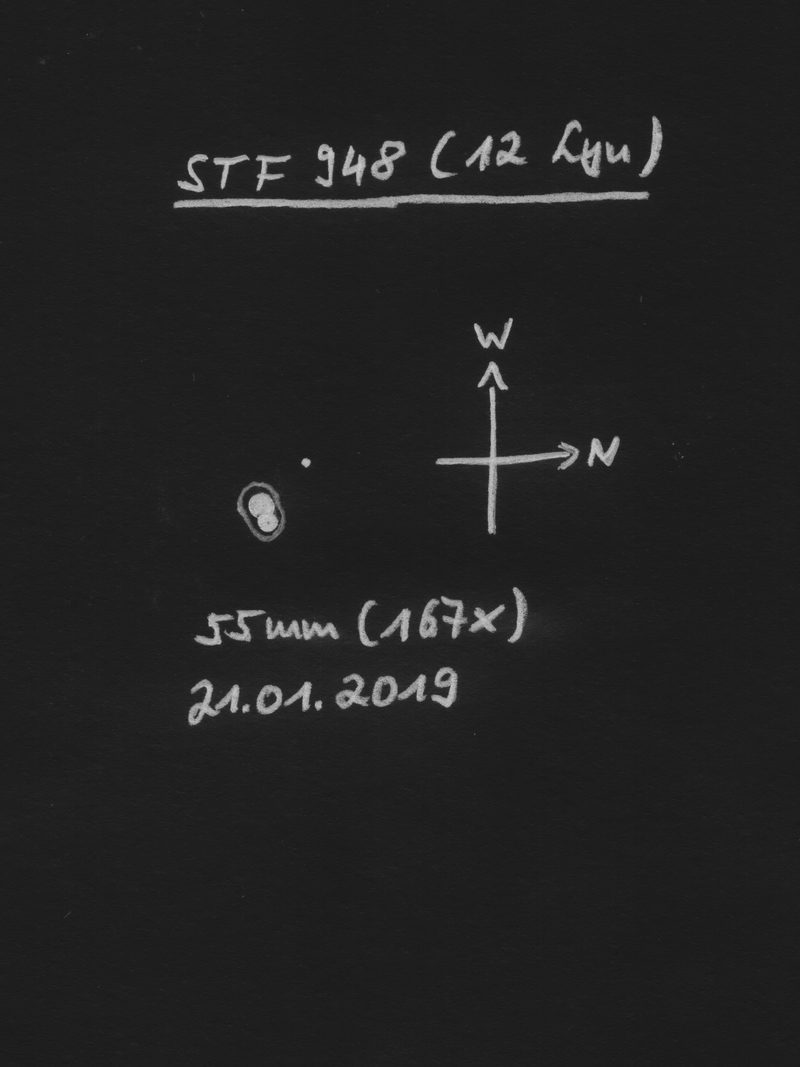
|
Robert Zebahl
Leipzig (Germany) |
63mm (140x) |
AB: Components A and B split with almost no space in between. The difference in brightness was visible. |
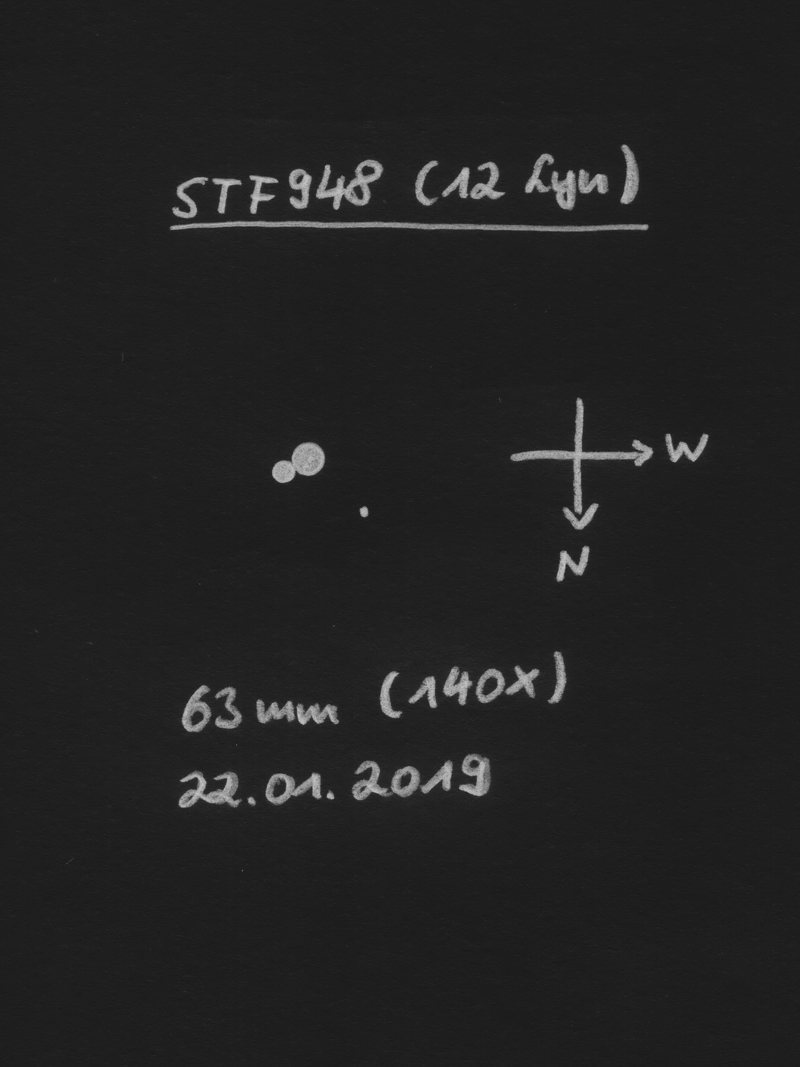
|
Robert Zebahl
Leipzig (Germany) |
70mm (22x) |
AC: Well split, relatively close together with significant difference in brightness. |
|
Robert Zebahl
Leipzig (Germany) |
70mm (133x) |
AB: Both components A + B clearly split, whereby the diffraction rings where merged together. A very nice view together with component C. I sketched this triplet, which reflects my impression well. Unfortunately, the distance and position angle are not particularly well observed. Also the difference in brightness I didn't noticed during my observation. |

|
Robert Zebahl
Leipzig (Germany) |
102mm (129x) |
At 28x the pair AC is nicely separated without any problems. The close pair AB is already recognizable at 86x as a clear figure '8', at 125x wonderfully separated. The components A & B appear yellowish. Very nice view together with STF 946 in one field of view! |
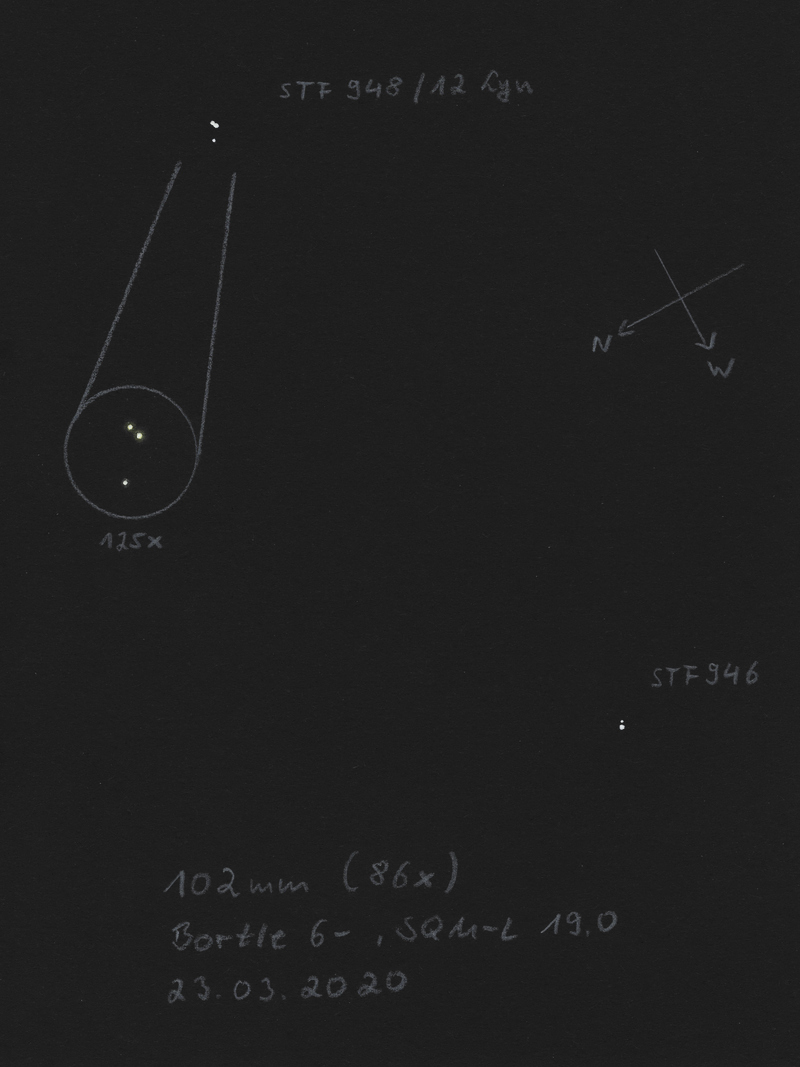
|
Uwe Pilz
Leipzig (Germany) |
105mm (88x) |
im selben Feld mit STF 946 |
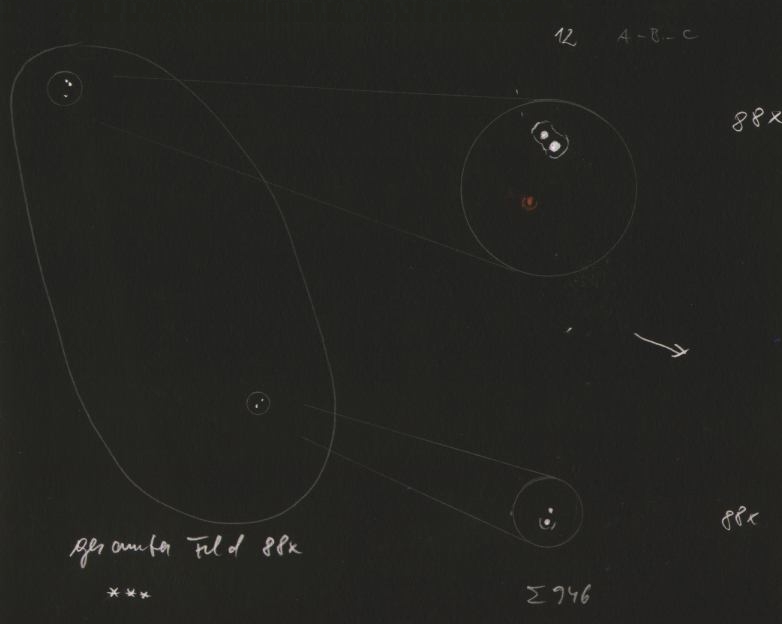
|
Robert Zebahl
Leipzig (Germany) |
152mm (129x) |
At 49x the pair AC is beautifully separated with a significant difference in brightness. At 100x, the close pair AB is also separated, although still very close together. A slight difference in brightness is noticeable. At 129x, the view is magnificent. The two bright components A & B present themselves yellowish, the fainter component C rather greyish. STF 948 can be well observed in a field of view with the neighbouring double star STF 946. Both show a nice overall scenery. |
|
Mark McCarthy
Fremont (California/USA) |
178mm (148x) |
AB: Gorgeous triple star, pale yellow A and B, and 1 delta blue C. really stunning. AB physical with a 733-year period |
|
|
|
★★
|
STTA80 |
|
AB |
7m.2 |
7m.4 |
124.1" |
53° |
2015 |
Gem |
06h58m06.59s / +14°13'43.40" |
|
|
|
|
AC |
7m.2 |
8m.4 |
81.2" |
112° |
2015 |
|
|
Christopher Hay
Seeheim (Germany) |
7x45 |
Handheld. AB are a well separated, matching pair. Immediately striking in field. |
|
Christopher Hay
Seeheim (Germany) |
15x45 |
Binoculars with internal stabilisation, handheld. AB are a widely separated pair, and joined by a third, weaker, point of light, which is C, well separated. A charming little triangle.
Involved in (or making up?) Monti 4 asterism. |
|
Robert Zebahl
Leipzig (Germany) |
70mm (22x) |
All 3 components form a striking triangle and are slightly different in color. A (western component): white-bluish; B (northern component): white-yellowish; C (southern component): orange, partly slightly reddish. |
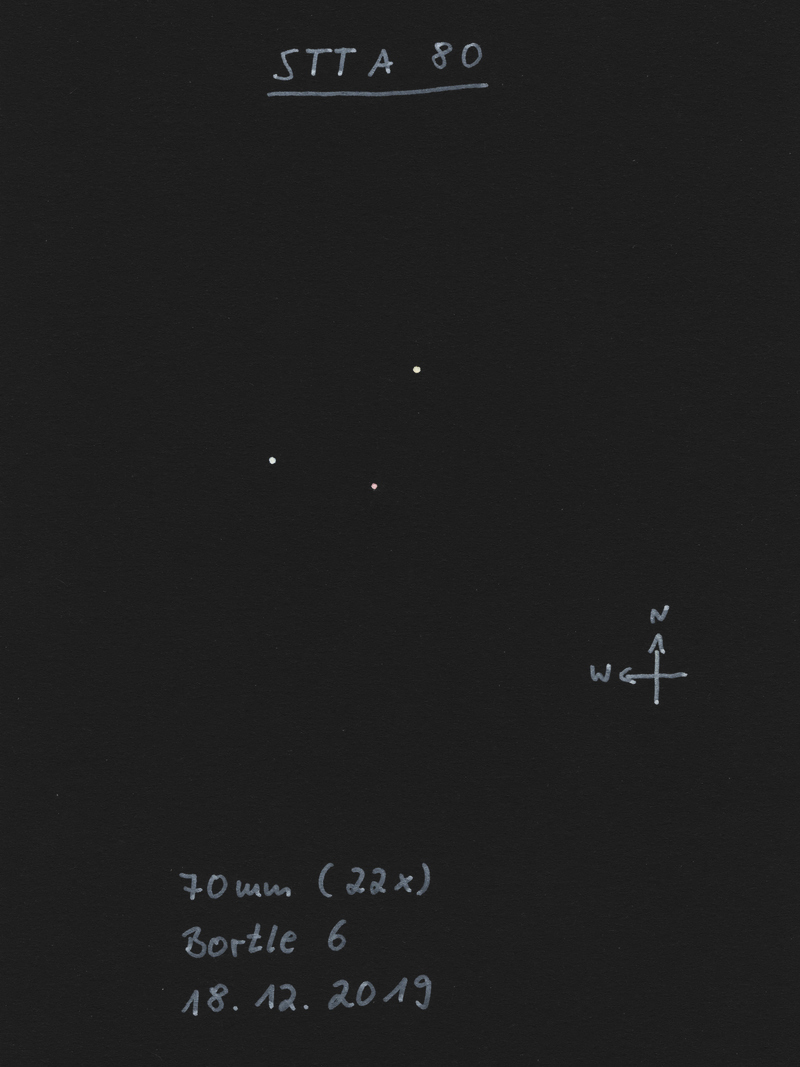
|
|
|
★★★
|
zeta Cnc, 16 Cnc |
STF1196 |
AB |
5m.3 |
6m.2 |
1.1" |
359° |
2021 |
Cnc |
08h12m12.79s / +17°38'51.20" |
|
|
|
STF1196 |
AB-C |
4m.9 |
5m.8 |
6.0" |
64° |
2020 |
|
|
|
|
|
STF1196 |
AC |
5m.3 |
5m.8 |
6.2" |
62° |
2020 |
|
|
|
|
|
HUT1 |
Ca-Cb |
6m.2 |
7m.1 |
0.3" |
344° |
2021 |
|
|
|
|
Robert Zebahl
Leipzig (Germany) |
70mm (133x) |
The wide pair AB-C is already separable at 22x. The pair AB shows at 133x two clearly overlapping diffraction disks with small difference in brightness, but without any notch. |
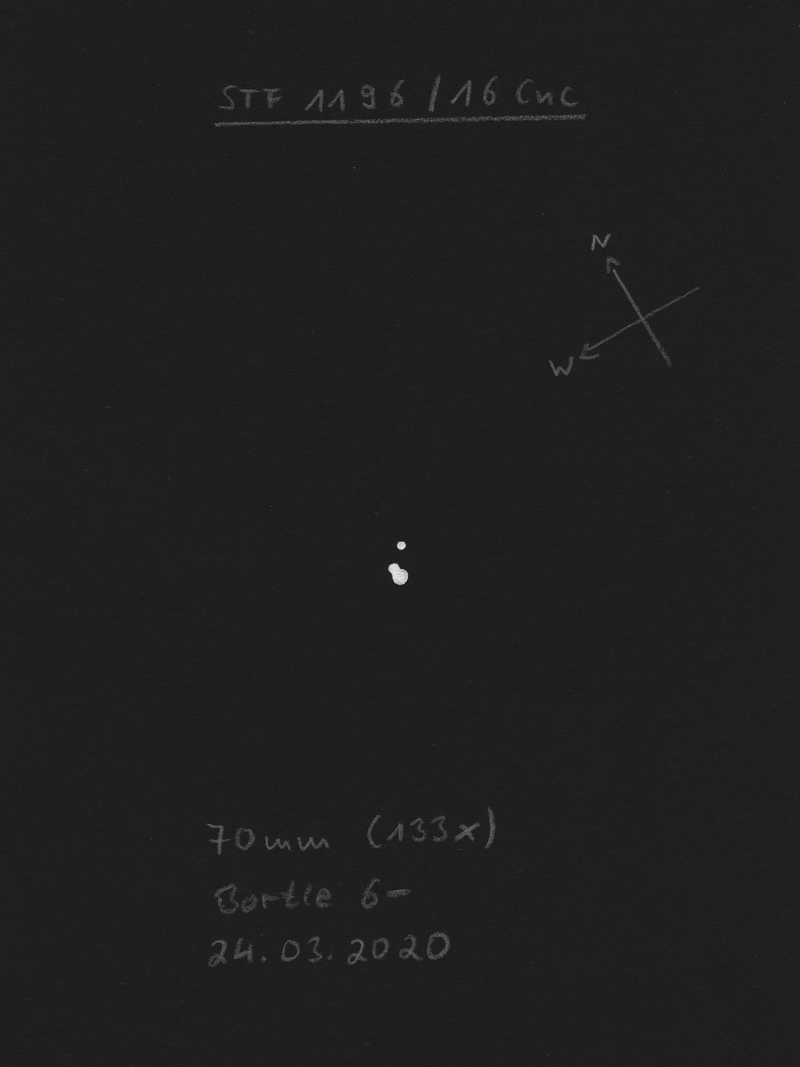
|
Christopher Hay
Seeheim (Germany) |
71mm (32x) |
AB-C: Finely split. AB yellowish. Substantial delta-mag. |
|
Robert Zebahl
Leipzig (Germany) |
102mm (86x) |
AB-C: Easy to separate. A: light grey, B: pale orange. |
|
Stefan Loibl
Rosenheim (Germany) |
102mm (164x) |
AB-C clearly split, AB obviously elongated but not split |
|
Uwe Pilz
Leipzig (Germany) |
105mm (288x) |
weißblau-gelb-gelb |
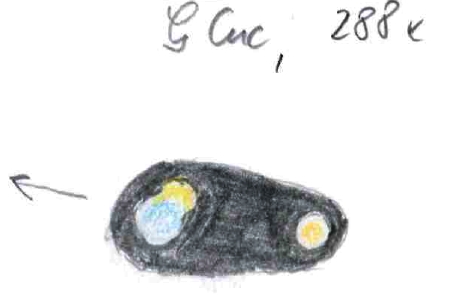
|
Robert Zebahl
Leipzig (Germany) |
120mm (67x) |
AB-C: Evident difference in brightness, easy to split. Both components of similar color. |
|
Robert Zebahl
Leipzig (Germany) |
120mm (200x) |
AB: Very tight. The Airy disks were still touching. Slight difference in brightness. Extremely beautiful triple star! |
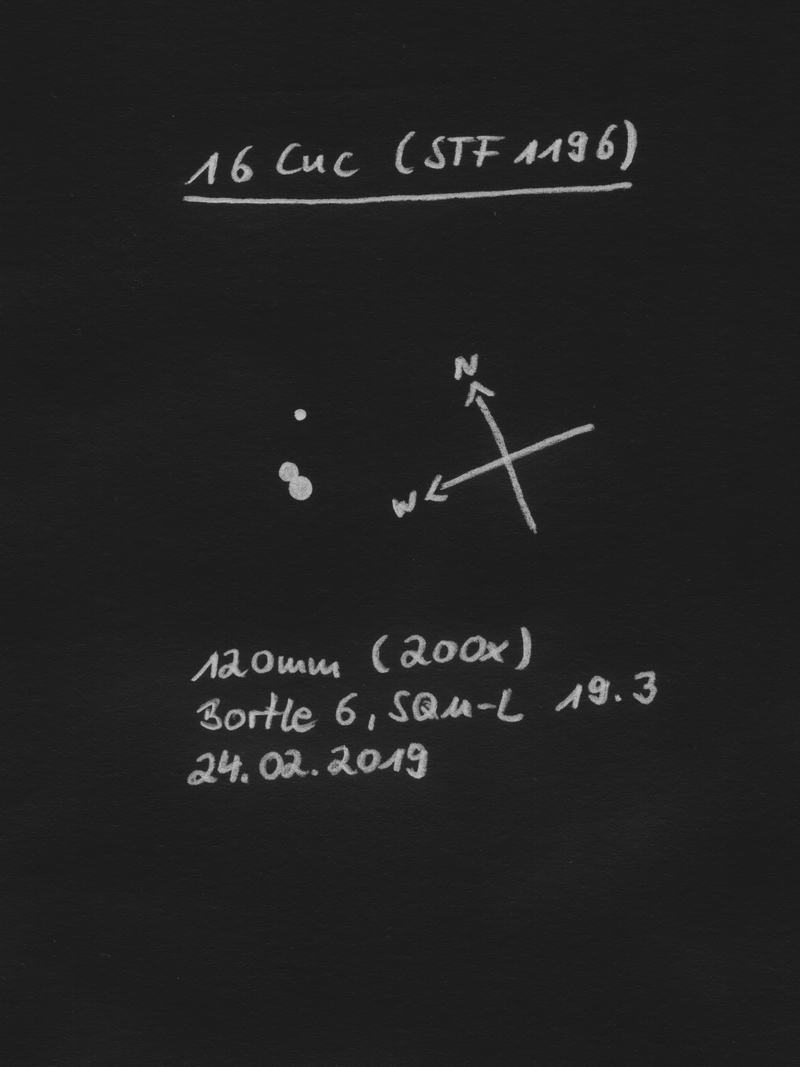
|
Winfried Kräling
Marburg (Germany) |
127mm (250x) |
08.04.2018: Sehr schön, 3-fach Stern, A = weißgelb, B = weißgelb, C = weißgelb |
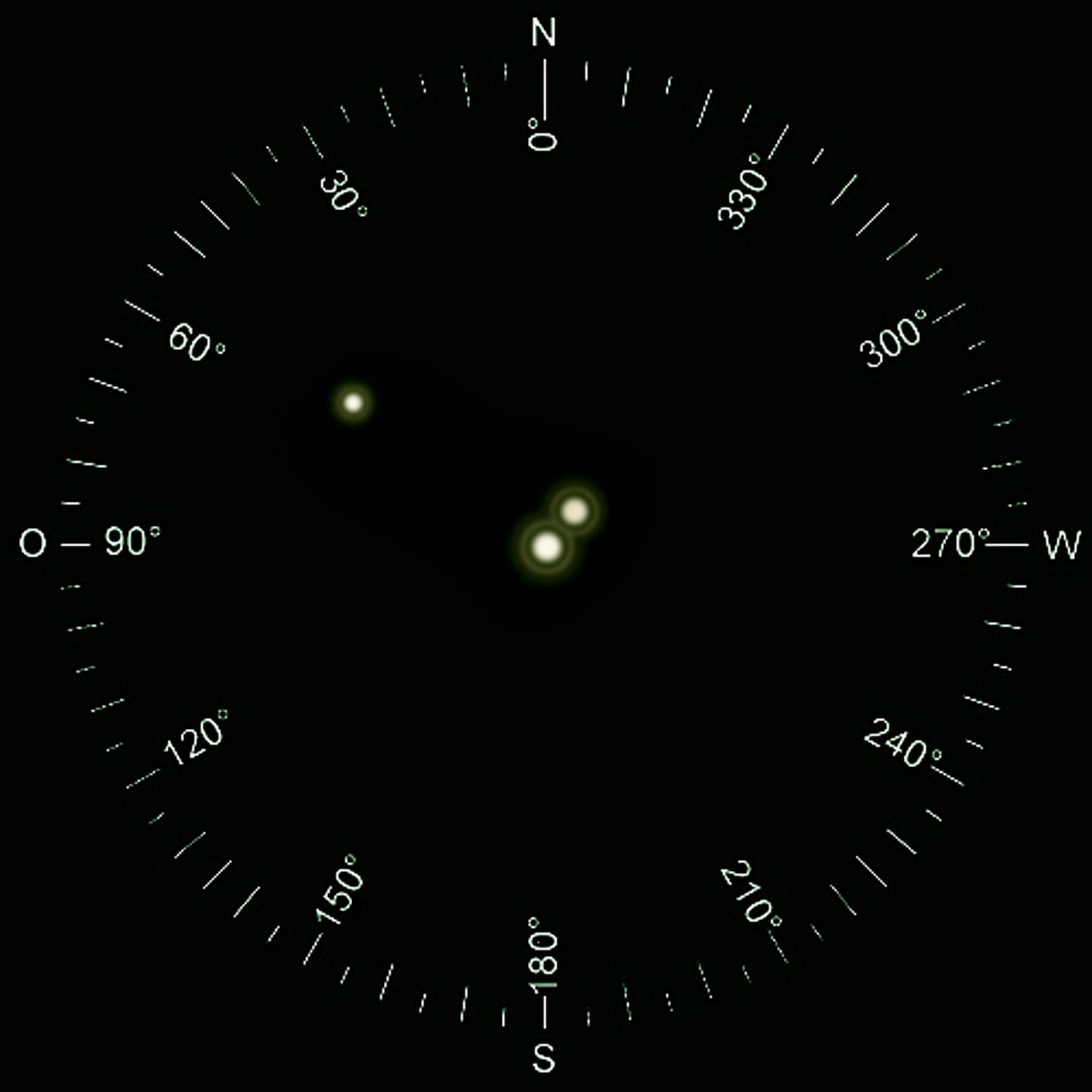
|
Sarah Gebauer
Germany |
150mm (83x) |
AB-C: bei 83x sind AB-C sauber getrennt, laut Atlas 2020 6,1'' Abstand, die Komponenten A und B mit 1,1'' lassen sich nicht trennen, viele schöne Feldsterne dabei |
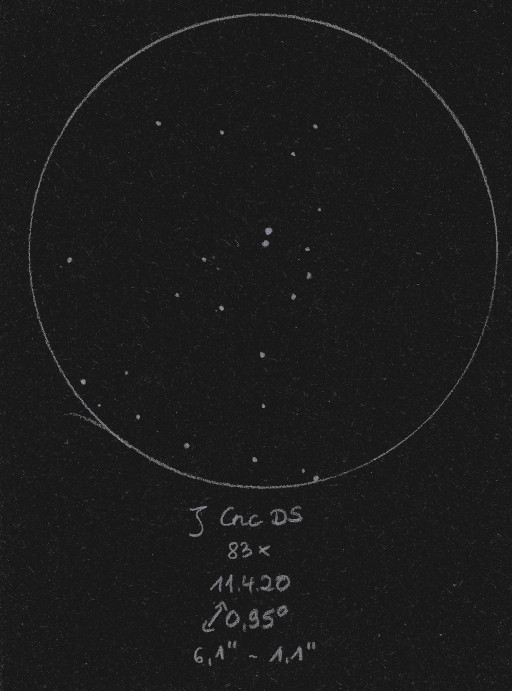
|
Christopher Hay
Seeheim (Germany) |
180mm (200x) |
AB: Hair-fine split. A and B both yellowish-white. C wide from AB, bluish-white, nice colour contrast to AB. |
|
Mark McCarthy
Fremont (California/USA) |
317mm (553x) |
Ca-Cb: not quite round, oval/olive shaped. It is the AB-C of STF 1196. |
|
Mark McCarthy
Fremont (California/USA) |
317mm (553x) |
AB: Triple, all near equal magnitude, yellow-white. AB ~0.8", hair split. |
|
Mark McCarthy
Fremont (California/USA) |
317mm (553x) |
AC: Triple, all near equal magnitude, yellow-white. AC ~6", wide split. |
|
Karsten Kopp
Köln (Germany) |
600mm (257x) |
AB: Die Komponenten AB-C bei etwas größerem Helligkeitsunterschied einfach zu trennen und auch schön anzusehen. Sterne erstrahlen weißlich gelb. Komponente AB war nicht zu trennen. |
|
|
Frederik Wanink
Itterbeck (Germany) |
254mm |
AB-C |
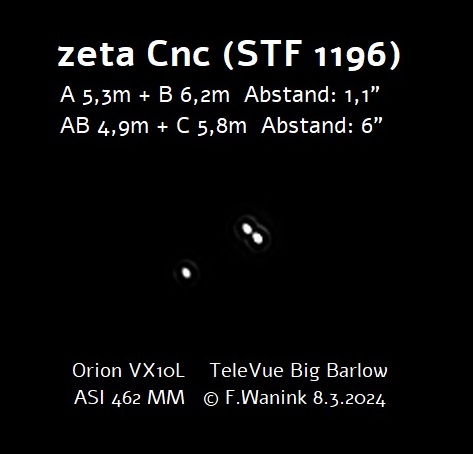
|
|
|
|
ENG37 & SLE335 & SLE685, 39/40 Cnc |
ENG37 |
AB |
6m.5 |
6m.6 |
151.8" |
150° |
2015 |
Cnc |
08h40m06.44s / +20°00'28.10" |
|
|
|
ENG37 |
AC |
6m.5 |
9m.0 |
134.0" |
309° |
2015 |
|
|
|
|
|
ENG37 |
AD |
6m.5 |
8m.8 |
134.9" |
111° |
2015 |
|
|
|
|
|
SLE685 |
AR |
6m.5 |
11m.6 |
290.3" |
150° |
2001 |
|
|
|
|
|
SLE335 |
AS |
6m.5 |
10m.1 |
261.7" |
325° |
2002 |
|
|
|
|
|
SLE335 |
CS |
9m.0 |
10m.1 |
137.1" |
340° |
2002 |
|
|
Christopher Hay
Seeheim (Germany) |
71mm (32x) |
All members A, B, C and D clearly seen and widely separated. A compact group at the northern fringe of M 44 (Praesepe, the Beehive). Component A seems orangish.
Engelmann 37ABCD is a physical group at a distance to us of 608 light years.
Stelledoppie notes about the ENG designation: Some time after publication of the IDS, the designation for Engelmann was changed from EN to ENG and that for Engelhardt from ENG to ENH. This has led to considerable confusion between the two. |
|
|
|
★
|
S654 & SHY633 |
S654 |
AB |
5m.6 |
8m.9 |
71.3" |
239° |
2018 |
CVn |
13h46m59.77s / +38°32'33.70" |
|
|
|
SHY633 |
AC |
5m.6 |
8m.9 |
999.9" |
296° |
2020 |
|
|
Christopher Hay
Seeheim (Germany) |
7x42 |
AB: With handheld 7x42 binoculars I cannot separate B from A. With handheld 10x42 binoculars with internal stabilisation, B emerges in fleeting moments from the glare of A, wide. Yellow-orange hue of A that I had already noticed with 7x42 binoculars becomes clearer with 10x42.
With stabilised 20x60 binoculars I can hold B constantly, but B is far more difficult than component C (AC = Shaya 633) despite B and C having practically identical brightnesses.
AC: With handheld 7x42 binoculars component C is clear and very wide from A. A seems yellow-orange. Not visually exciting, it is nonetheless pleasurable to contemplate that this is in fact a physical pair travelling together in space, 317 light years distant from us.
SHY = E.J. Shaya, R. Olling, 2011: Very Wide Binaries and Other Comoving Stellar Companions: A Bayesian Analysis of the Hipparcos Catalogue. Component A is HIP 67250, C is 67041. AB is also physical, hence ABC is a triple system. |
|
Sarah Gebauer
Germany |
100mm (21x) |
S654 (AB): 02.10.23: bei 21-fach gut und weit getrennt, die nordöstliche Komponente strahlt sehr schön hellgolden, die südwestliche ist ein dunkelgraues Pünktchen - in etwa fünffachem Abstand südwestlich strahlt der benachbarte Stern HD120048 in einem schön kontrastreichen Warmweiß - bei 49-fach ist der Anblick auch noch schön, der Goldton von A intensiviert sich ins Roségoldene |
|
René Merting
Drachhausen (Germany) |
100mm (32x) |
S654 (AB): bei 32x ein weit getrenntes Pärchen - B im Südwesten ist deutlich schwächer und farblos ggü. der weiß strahlenden Komponente A |
|
Mark McCarthy
Fremont (California/USA) |
317mm (277x) |
S654 (AB): Striking yellow-orange and blue-green fainter B. |
|
|
|
★★★
|
mu Boo, 51 Boo, Alkalurops |
CHR181, mu 1 Boo |
Aa-Ab |
4m.3 |
|
0.1" |
188° |
2012 |
Boo |
15h24m29.54s / +37°22'37.10" |
|
|
|
STFA28, mu 1 Boo |
AB |
4m.3 |
7m.1 |
109.2" |
171° |
2020 |
|
|
|
|
|
STF1938, mu 2 Boo |
Ba-Bb |
7m.1 |
7m.6 |
2.2" |
2° |
2020 |
|
|
|
|
Christopher Hay
Seeheim (Germany) |
7x45 |
STFA28 (AB): Handheld. Wide split. A compact uneven pair. Component A is bluish-white.
Rather charming in 8.6° FOV with Nu1/2 Boo, which has a gorgeous colour contrast, golden-orange and ice-blue, making it one of the strongest colour-contrast pairs in the sky for binoculars and greatly accentuating the sight of Mu Boo.
In 15x45 binoculars STFA28 AB is very wide, component A bluish-white, B warmer. |
|
Robert Zebahl
Leipzig (Germany) |
8x40 |
STFA28 (AB): Easily split with obvious difference in brightness. |
|
Robert Zebahl
Leipzig (Germany) |
16x70 |
STFA28 (AB): 2021-06-14: Wide, relatively striking pair. Pale yellow & dark orange. |
|
René Merting
Drachhausen (Germany) |
16x70 |
STFA28 (AB): weit getrenntes Pärchen, aufgrund der großen Helligkeitsunterschiedes schöner Farbkontrast - Komponente A im Norden gelblich, B im Süden mehr grau-braun |
|
Robert Zebahl
Leipzig (Germany) |
70mm (22x) |
STFA28 (AB): Evident, very wide apart and unequal. A: white-yellowish, B: grey. |
|
Mark McCarthy
Fremont (California/USA) |
80mm (94x) |
STFA28 (AB): Alkalurops Bright yellow-white A and bluish B, which is itself a slightly unequal close double, finely split (STF 1938 Ba,Bb) -- 256.5-year period, now coming off apastron |
|
Sarah Gebauer
Germany |
100mm (21x) |
STFA28 (AB): 02.10.23: bei 21-fach sehr eindeutig auszumachen, das Paar sticht durch eine sehr helle, blass zitronengelbe A-Komponente und eine graue bis schmutzig weiße, weit abgesetzte B-Komponente hervor |
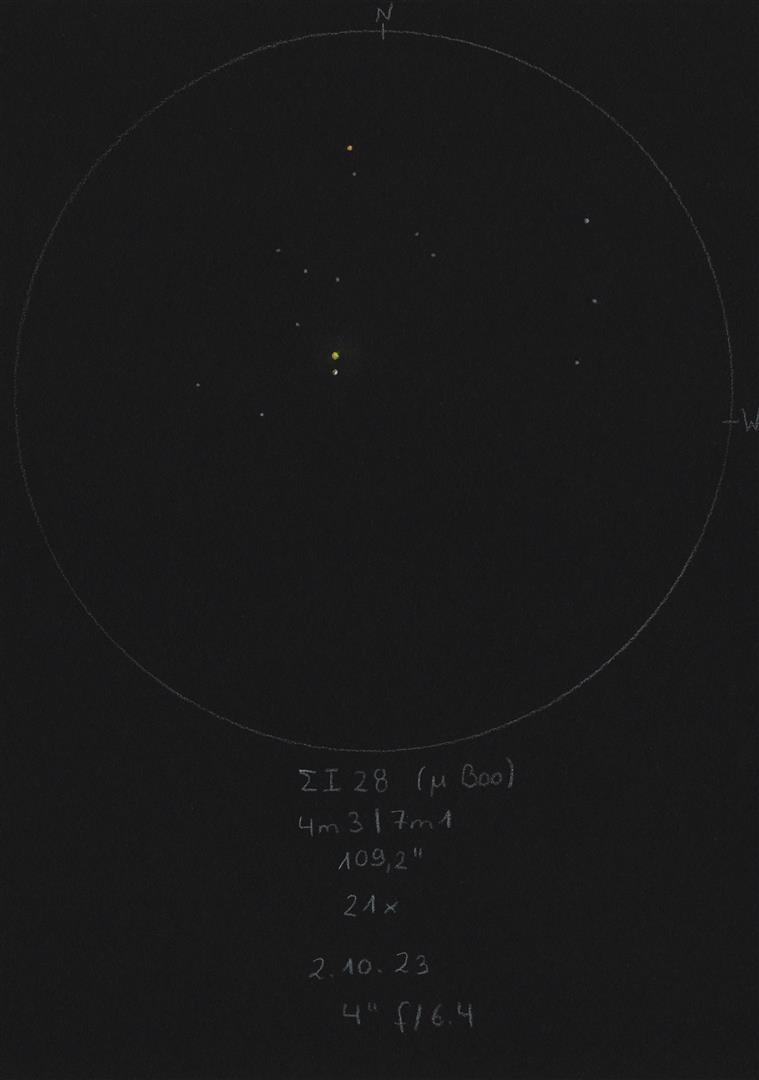
|
Sarah Gebauer
Germany |
100mm (49x) |
STFA28 (AB): bei 49-fach sehr hell und sehr weit, unterschiedlich hell und dominiert das ohnehin schon eher leere Gesichtsfeld |
|
Robert Zebahl
Leipzig (Germany) |
102mm (125x) |
Beautiful view! This triple system includes STFA 28 and STF 1938. |
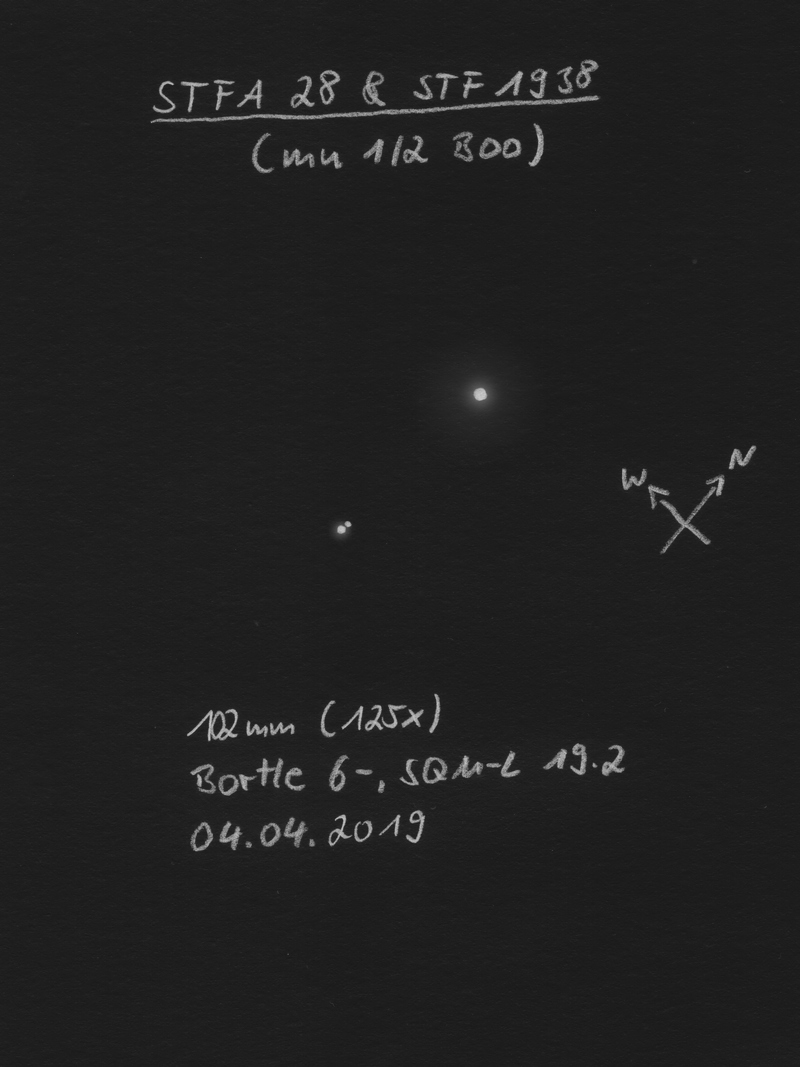
|
Uwe Pilz
Leipzig (Germany) |
105mm (288x) |
ein heller 4m und zwei nahe dunkle 7m, lohnend. |
|
René Merting
Drachhausen (Germany) |
107mm (30x) |
STFA28 (AB): AB: das Paar ist bei 30x komfortabel getrennt erkennbar, A strahlt leicht gelblich - Komponente B besteht aus zwei Sternen Ba, Bb (STF 1938), die ab 120x getrennt zu sehen sind - Bb im Norden ist gut eine viertel bis halbe Größenklasse schwächer als Ba |
|
René Merting
Drachhausen (Germany) |
107mm (120x) |
STF1938 (Ba-Bb): bei 86x ist nördlich von Ba ein zweiter etwas schwächerer Stern erkennbar, er klebt noch an Ba - 120x reichen dann für eine knappe Trennung - Bb im Norden ist eine viertel bis halbe Größenklasse schwächer |
|
Robert Zebahl
Leipzig (Germany) |
120mm (23x) |
STFA28 (AB): Easy to split with large angular distance and noticeable difference in brightness. |
|
Sarah Gebauer
Germany |
150mm (125x) |
A-BC mit 109'' sind bei 125x sehr weit getrennt, es ist der Ansatz eines engen Doppelsterns zu erkennen, der sich mit 2,2'' Abstand auch bis 250x nicht auftrennen ließ |
|
Christopher Hay
Seeheim (Germany) |
180mm (105x) |
STF1938 (Ba-Bb): At 105x in poor seeing a kissing, evenly matched pair. At 180x clearly split despite the poor seeing, southern component (Ba) seems slightly brighter than Bb. |
|
Mark McCarthy
Fremont (California/USA) |
203mm (205x) |
STFA28 (AB): Bright A star does not seem round. The B star is a tight equal pair, pretty set. [Aa,Ab is CHR 181 0.1", and I'd be shocked if I actually detected it. STFA 28 is technically the bright star and the tight pair, the tight pair is Ba,Bb = STF 1938, 7.09/7.63, 2.2"] |
|
Mark McCarthy
Fremont (California/USA) |
203mm (205x) |
STFA28 (AB): Bright A star does not seem round (CHR181). B star is a tight equal pair (STF1938 Ba-Bb). Pretty set. STFA 28 is technically the bright star and the tight pair |
|
Mark McCarthy
Fremont (California/USA) |
203mm (205x) |
CHR181 (Aa-Ab): Bright A star does not seem round (CHR181). B star is a tight equal pair (STF1938 Ba-Bb). Pretty set. STFA 28 is technically the bright star and the tight pair |
|
Mark McCarthy
Fremont (California/USA) |
203mm (205x) |
STF1938 (Ba-Bb): Bright A star does not seem round (CHR181). B star is a tight equal pair (STF1938 Ba-Bb). Pretty set. STFA 28 is technically the bright star and the tight pair |
|
Frederik Wanink
Itterbeck (Germany) |
254mm (640x) |
STF1938 (Ba-Bb): 3er System, schön |
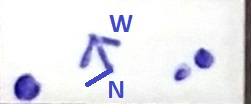
|
Mark McCarthy
Fremont (California/USA) |
317mm (277x) |
STFA28 (AB): Bright white star with tight yellow pair STF 1938 as its companion. |
|
Mark McCarthy
Fremont (California/USA) |
317mm (553x) |
STFA28 (AB): Striking. Bright star with near equal double STF 1938 paired with it. A star is a spectroscopic binary |
|
Mark McCarthy
Fremont (California/USA) |
317mm (553x) |
STF1938 (Ba-Bb): Near equal close but well split double also paired with STFA28 |
|
Karsten Kopp
Köln (Germany) |
600mm (257x) |
Hier handelt es sich um ein Dreifachsternsystem, welches jetzt aber nicht durch eine besondere Färbung der Sterne auffällt. Die A - B/C Komponenten stehen noch sehr weit auseinander, wobei auch die A-Komponente um einiges heller erscheint. Die beiden Komponenten B/C sind wesentlich näher beieinander und unterscheiden sich auch kaum in ihrer Helligkeit. |
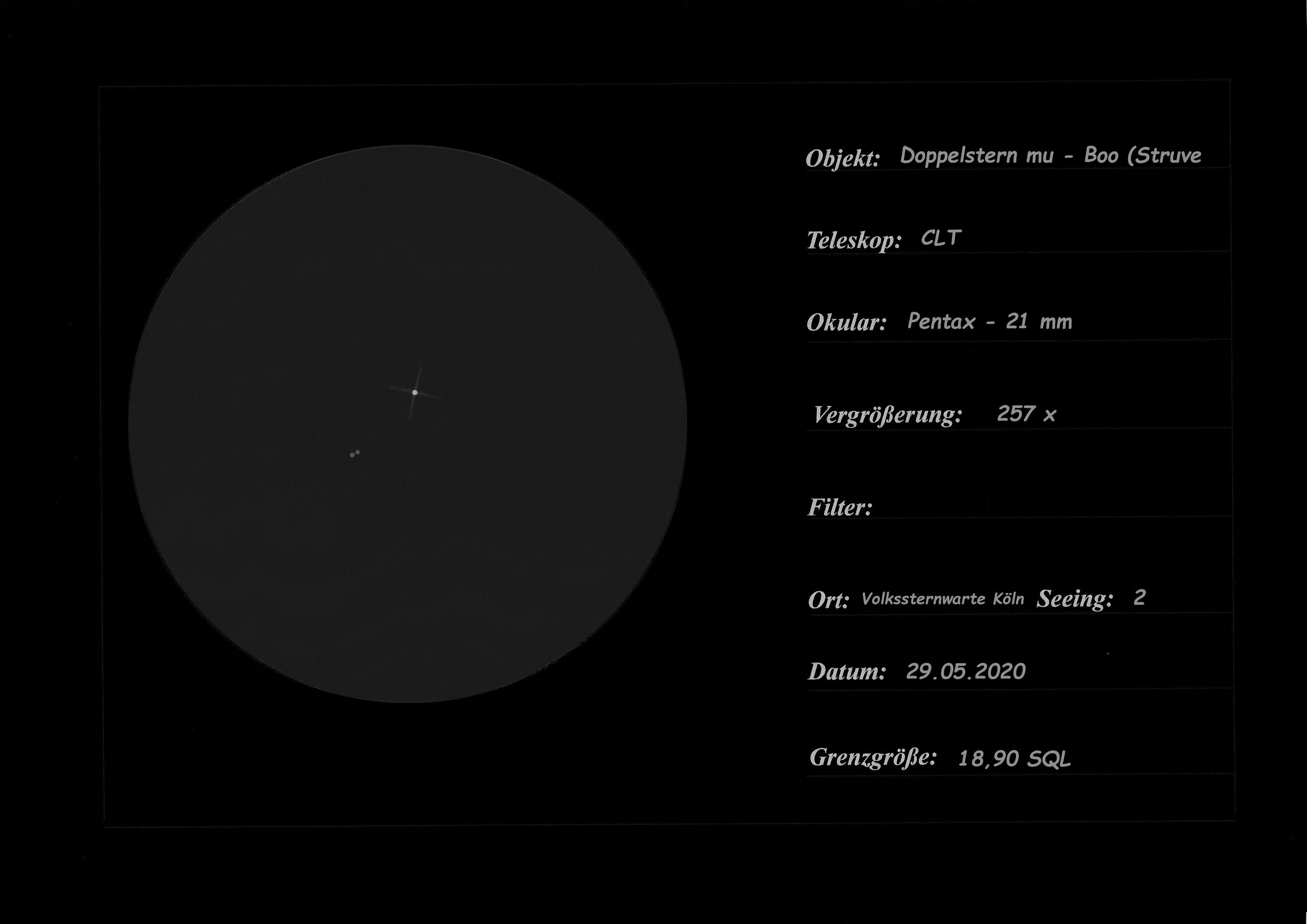
|
|
|
★★★
|
STF2078 & STFA30, 16/17 Dra |
STF2078, 17 Dra |
AB |
5m.4 |
6m.4 |
2.9" |
104° |
2021 |
Dra |
16h36m13.72s / +52°55'27.80" |
|
|
|
STFA30, 16/17 Dra |
AC |
5m.4 |
5m.5 |
90.2" |
193° |
2018 |
|
|
Christopher Hay
Seeheim (Germany) |
3x63 |
Clean split. Separation is much clearer than that of Nu1/2 Dra (STFA35), which is also in 14° FOV and is hair-fine split.
A physical double at a distance to us of 412 light years. |
|
Christopher Hay
Seeheim (Germany) |
7x45 |
A well split and nicely compact pair. When 16/17 Dra is put at the edge of the 8.6° field of view, Nu1/2 Dra stands at the opposite edge. Their comparison thus suggests itself. 16/17 is somewhat wider than Nu1/2. While the components of Nu1/2 are of equal brightness and whiteness, those of 16/17 display a slight difference in both brightness and colour. 17 (A) first seems bluer than 16 (C), but after 20 seconds this impression flips to C and from then on goes back and forth. |
|
Robert Zebahl
Leipzig (Germany) |
55mm (27x) |
STFA30 (AC): Rather wide pair with almost equal components. C component appeared slightly yellowish-orange. |
|
Robert Zebahl
Leipzig (Germany) |
55mm (71x) |
Grand sight! |
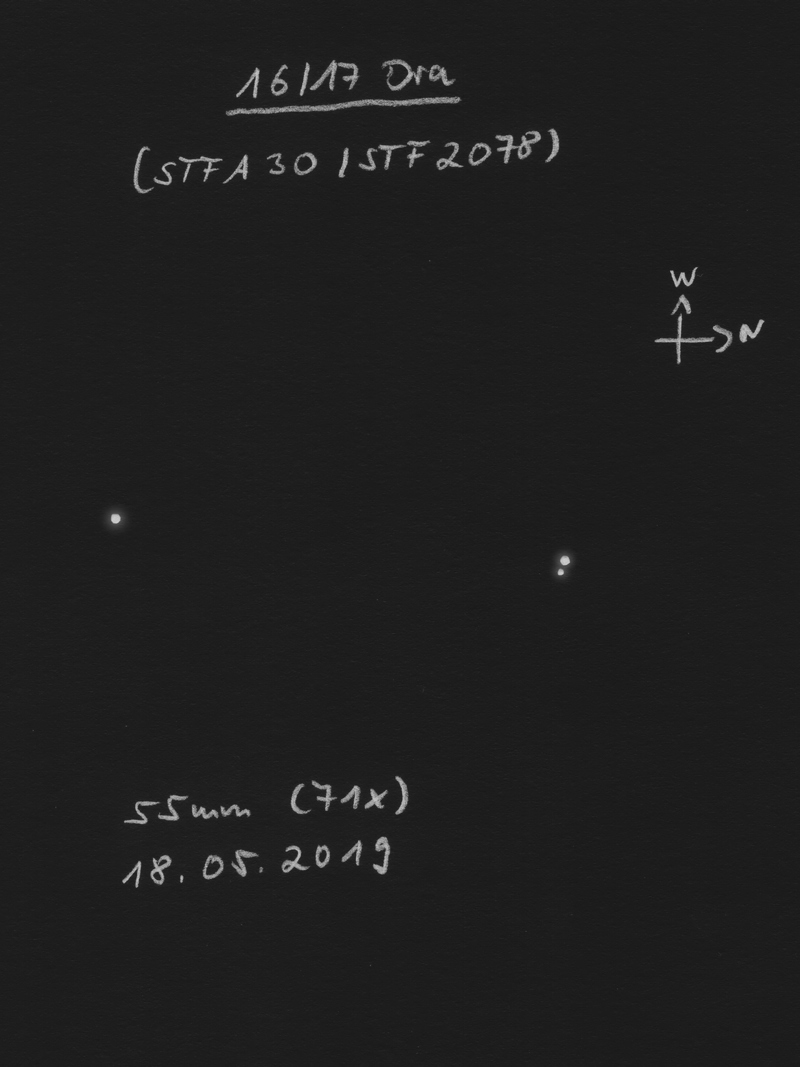
|
Christopher Hay
Seeheim (Germany) |
80mm (30x) |
16 Dra seems more bluish than 17 Dra, the latter seems slightly yellow in comparison and is distinctly elongated. At 84x 17 Dra is cleanly split and such a delightful view together with 16 Dra that I had no desire to ramp up the magnification. All three stars belong to a physical system. |
|
Sarah Gebauer
Germany |
100mm (80x) |
01.10.23: das Doppel 16/17 Dra zeigt bei 80-fach zum ersten Mal eine feine, warmweiße B-Komponente extrem knapp östlich neben der warmweißen, leicht gelblichen A-Komponente - Komponente C im Süden strahlt reinweiß und wirft einen ebenso großen Halo wie AB zusammen, sodass sich beide Halos überlagern - die D-Komponente ist als grauer, schwacher Stern südöstlich versetzt zu sehen |
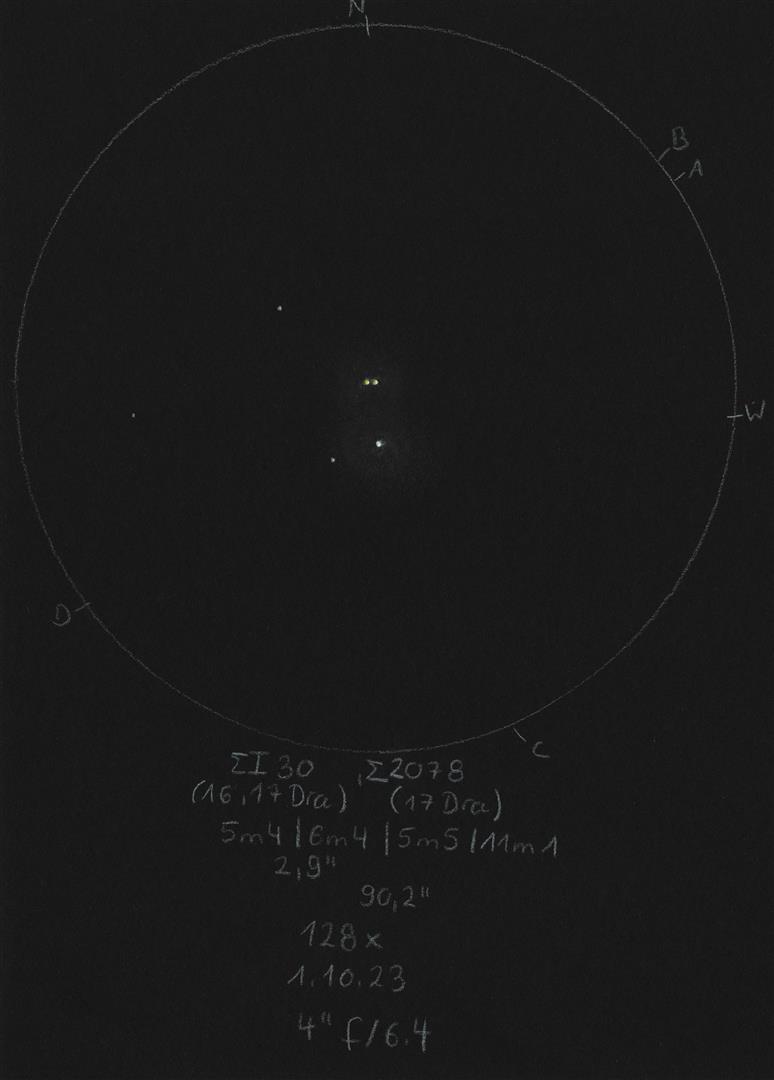
|
René Merting
Drachhausen (Germany) |
100mm (107x) |
AB: bei 64x noch ein Stäbchen, bei 107x ist B dann knapp getrennt östlich von A erkennbar - B ist auch noch relativ hell bzw. maximal eine Magnitude schwächer
AC: bei 32x weit auseinander stehend - Komponente C im Süden ist maximal eine viertel Magnitude schwächer - leichter Farbkontrast, A weißgelb und C kühlweiß |
|
Frederik Wanink
Itterbeck (Germany) |
254mm (640x) |
STF2078 (AB): sehr schönes Dreiersystem |
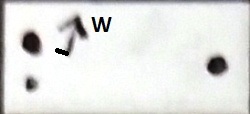
|
|
|
★★★
|
STFA50, 30/31 Cyg, omicron Cyg |
|
AC |
3m.9 |
7m.0 |
108.6" |
173° |
2016 |
Cyg |
20h13m37.90s / +46°44'28.80" |
|
|
|
|
AD |
3m.9 |
4m.8 |
336.7" |
322° |
2016 |
|
|
Robert Zebahl
Leipzig (Germany) |
naked eye |
AD: Well split with noticeable difference in brightness. |
|
René Merting
Drachhausen (Germany) |
naked eye |
meist sehe ich nur einen diffusen Lichtpunkt und dann irgendwann … immer wieder sind A und D klar erkennbar und getrennt voneinander zu sehen - D steht in Richtung Nordwesten von A aus gesehen |
|
Sarah Gebauer
Germany |
naked eye |
AC: 16.09.23 Jeßnigk: Ohne zu wissen, dass es möglich ist, lässt sich Omicron 1 Cygni in beide Komponenten auftrennen - mit deutlichem Helligkeitsunterschied und sichtbarem Abstand zueinander sind beide Sterne sehr gut einzeln zu sehen |
|
Christopher Hay
Seeheim (Germany) |
3x63 |
AD: Self-built binoculars, hence the unusual specification.
Widely split, A (31 Cyg) light orange, D (30 Cyg) light blue. |
|
Christopher Hay
Seeheim (Germany) |
7x50 |
A-D: Widely split, A (31 Cyg) luminous orange-red, D (30 Cyg) luminous ice-blue. C set off from A as a fine speck of light. |
|
Robert Zebahl
Leipzig (Germany) |
8x40 |
AC: Observation at full moon. Easily split with big difference in brightness. Brighter component slightly orange. C component rather faint. |
|
Robert Zebahl
Leipzig (Germany) |
8x40 |
AD: Wonderful double star for binoculars. Large distance of the components, brighter once (31 Cyg) appeared slightly orange, the fainter (Cyg 30) more bluish. |
|
Christopher Hay
Seeheim (Germany) |
15x45 |
A-D: Very wide apart but still perceived as belonging together. A (31 Cyg) orange-red, D (30 Cyg) ice-blue. C well set off from A and light ice-blue, like an echo of D. A delightful group of three for binoculars at this power, further accentuated by nearby orange Omicron2 Cygni. Both the brightnesses and colour hues of Omi1A and Omi2 appear practically identical. |
|
Robert Zebahl
Leipzig (Germany) |
16x70 |
2020-07-03: Fantastic sight. A: bright orange, D: white-bluish, C: light blue. Very beautiful field. |
|
René Merting
Drachhausen (Germany) |
18x70 |
wunderschön - Komponente A präsentiert sich buttergelb - die südliche, schwächste Komponente C zeigt sich aquamarinblau - D im Norden ist reinweiß und steht dreimal weitere entfernt wie AC |
|
René Merting
Drachhausen (Germany) |
76mm (57x) |
Mondscheinnacht - bei 29x ein wunderschönes Sterntrio, A wirkt goldgelb, D weiß mit einem Stich ins türkise, C ist kühlweiß mit einem Stich ins Blaue |
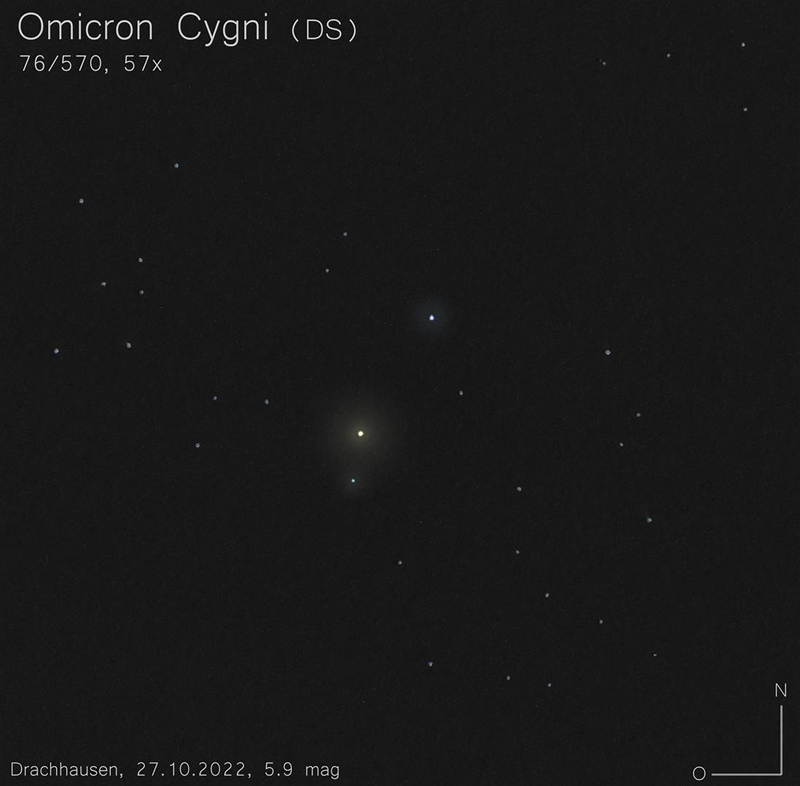
|
Robert Zebahl
Leipzig (Germany) |
80mm (25x) |
AC: Similar to the observation with binoculars. C component appeared bluish and gave good contrast to the orange colored 31 Cyg. |
|
René Merting
Drachhausen (Germany) |
100mm (32x) |
bei 32x sind alle drei Sterne weit getrennt und doch irgendwie zusammengehörend, Komponente A ist rapsgelb und am auffälligsten, Komponente D strahlt weiß und die schwächste Komponente C schimmert bläulich, schöner Anblick |
|
Robert Zebahl
Leipzig (Germany) |
102mm (28x) |
Bright, wide apart and wonderful contrast in color. A: light yellowish-orange, C: blue, D: light blue. |
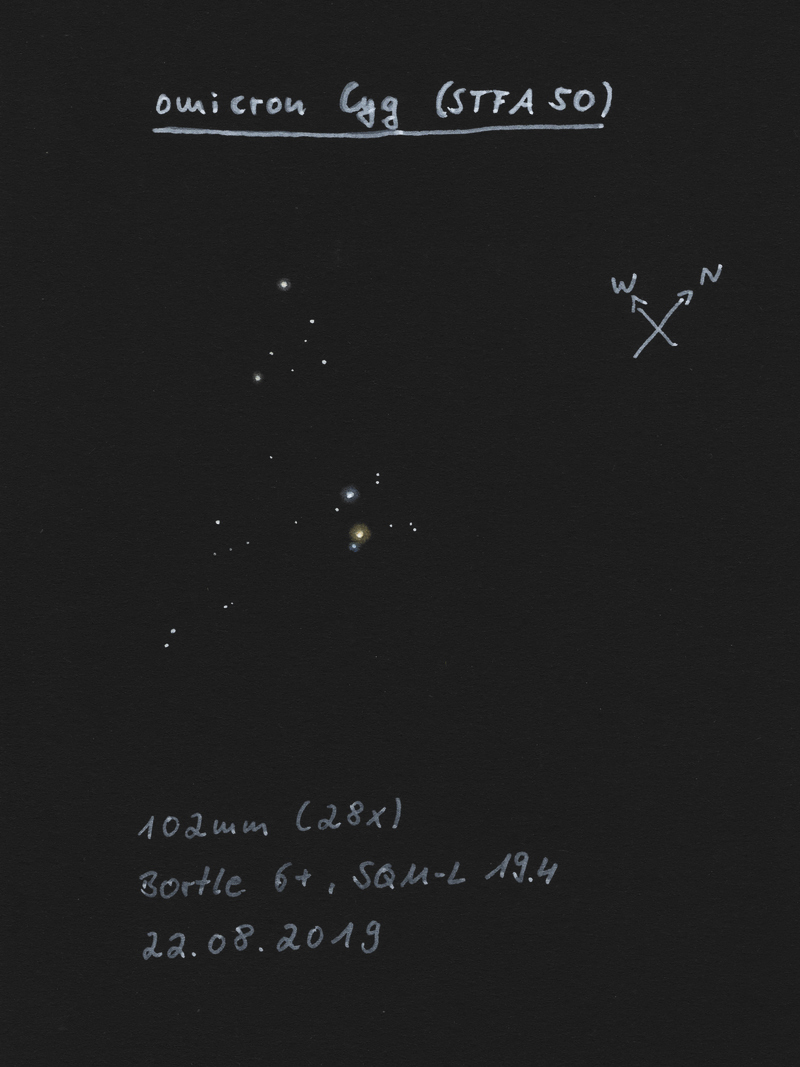
|
René Merting
Drachhausen (Germany) |
107mm (30x) |
|
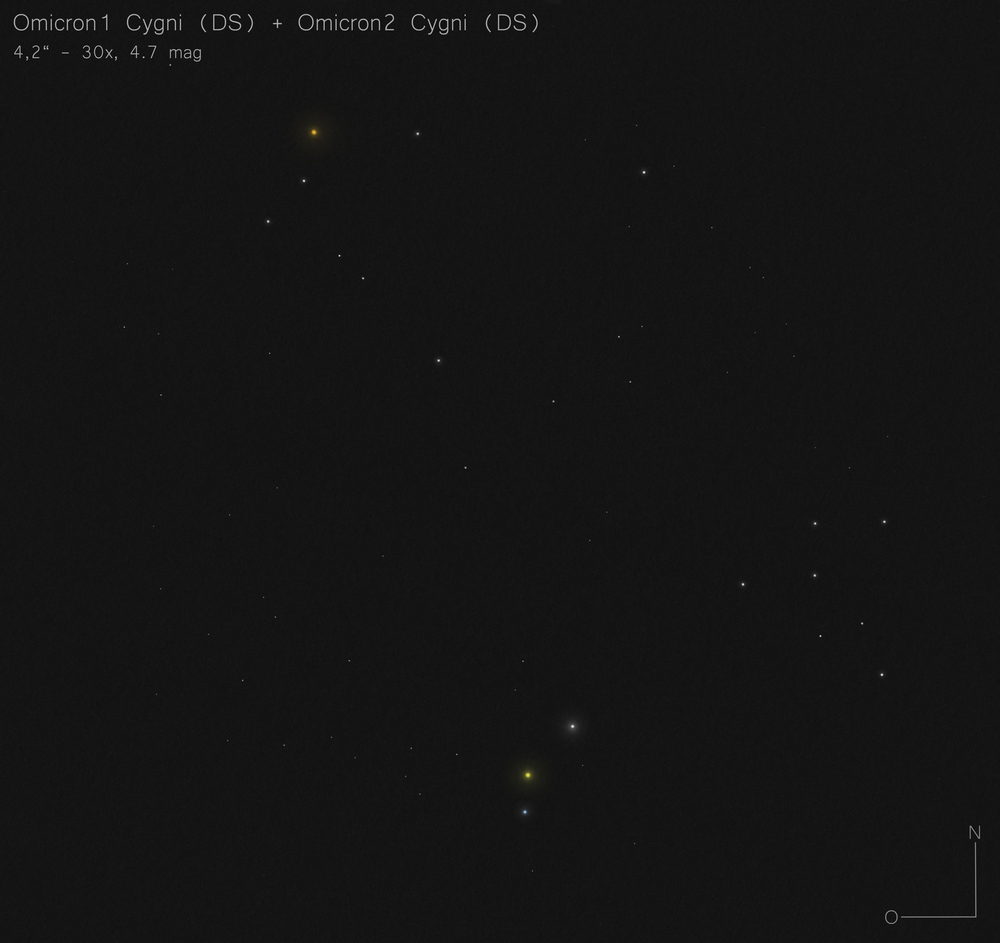
|
Sarah Gebauer
Germany |
150mm (30x) |
die drei Komponenten plus Omicron2 bilden ein wunderschönes, sehr langes und spitzes Dreieck und zeigen dabei wundervolle Farben, Komponente A von o1 sowie o2 erscheinen schön gelblich, Komponente D von o1 hat einen deutlichen Blaustich im Weißen, wirklich ein sehr schönes Gesamtbild - auf Komponente C hatte ich nicht geachtet |
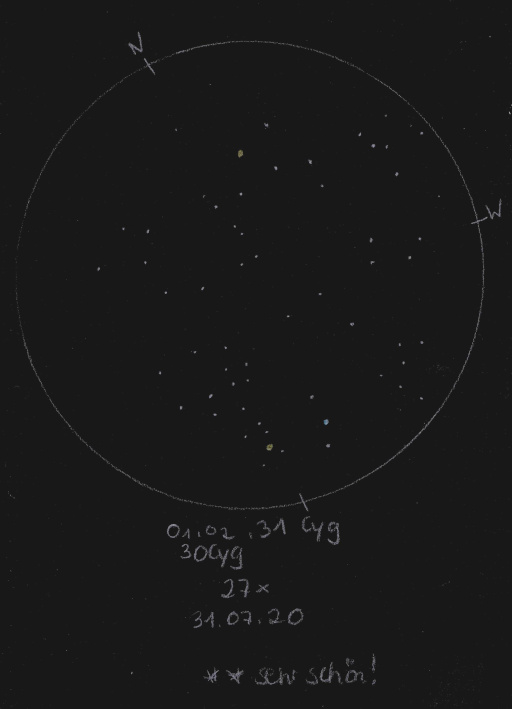
|
Sarah Gebauer
Germany |
150mm (85x) |
dieses Mal nur die drei dicht beieinanderstehenden Komponenten A, C und D im Sichtfeld gehabt, Komponente A ist wieder deutlich gelbgold, C wirkt leicht bläulich und Komponente D wirkt dieses Mal eher weiß |
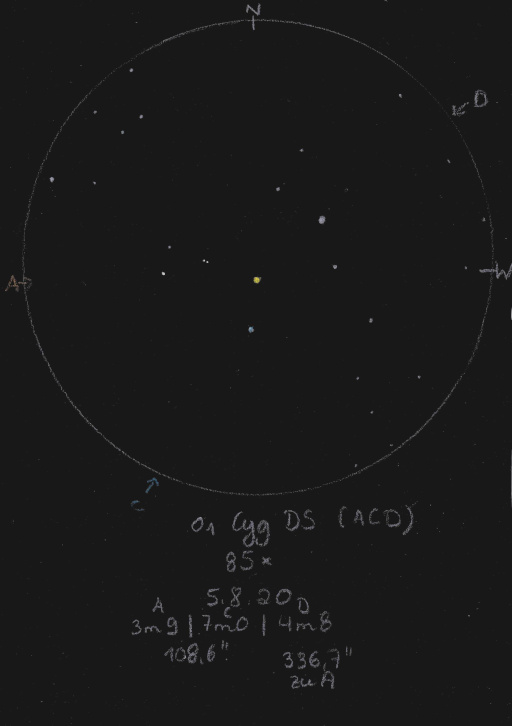
|
|
